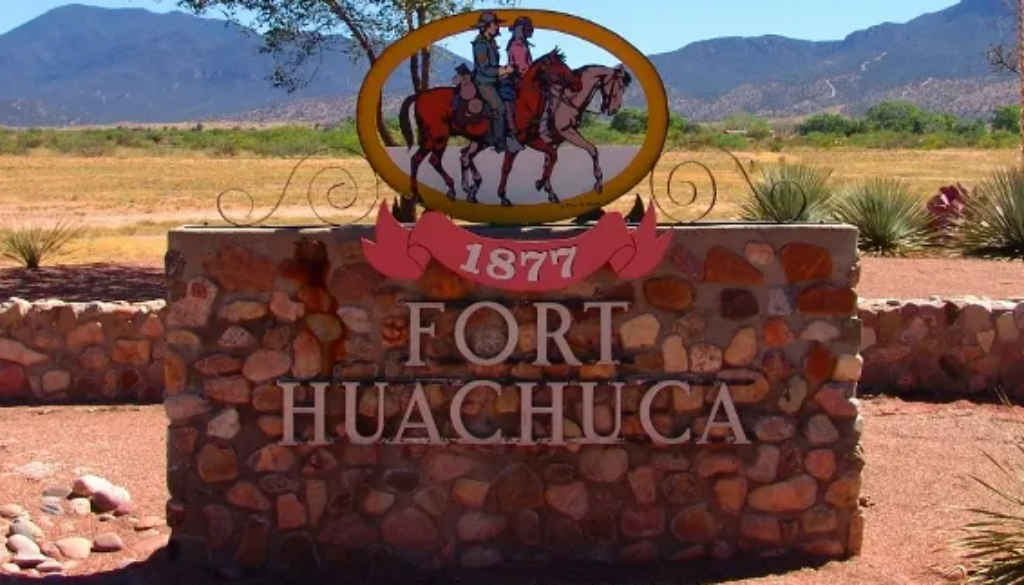Running dry – US Army base under fire for high water use in drought-stricken Arizona
By Carmela Guaglianone
The San Pedro River, nestled in southeastern Arizona’s San Pedro Valley just north of the US-Mexico border, is one of the last undammed rivers in the Southwest and is considered a biodiversity hotspot. Lined with cattails, willows and cottonwoods, the marshy waterway shelters hundreds of diverse bird species, including many considered endangered and protected by federal law.
The area is also home to the Fort Huachuca US Army base, which has been heralded as an example of the military’s efforts to become more environmentally conscientious due to its use of solar power and other “green” initiatives.
Ten years ago, Fort Huachuca forged a plan to achieve “net-zero” by 2025. But today, that goal has been largely abandoned, and an expanding group of critics says the installation’s well-meaning conservation efforts are falling short, and the Army instead is posing a dire threat to a protected conservation zone as a result of the base’s rampant pumping of precious groundwater.
The Army and the nearby municipalities whose residents rely on the base for employment, are the most prolific groundwater users, withdrawing an estimated 10,000 acre feet per year, according to a 2020 report from the U.S. geological society. That amount would fill nearly 41 million bathtubs. Around 25,000 military personnel, civilians, and family members are on base at any given time.
Water use at the fort and from the adjacent town of Sierra Vista and surrounding communities has been linked to a worrisome depletion in San Pedro River’s flow and the surface water of the nearby conservation zone. Studies produced by the fort and their state, federal and local partners, have consistently shown a massive overdraft of approximately 4,000 acre-feet annually from the sub-watershed feeding the fort and the conservation area.
A coalition of environmental organizations sued the base in 2020 for allegedly violating the Endangered Species Act (ESA) due to its water use. The court overseeing the case has directed the base to submit a report showing it complies with the ESA and that the base’s groundwater use would not put endangered species at risk. But the base has so far been unable to satisfy the court.
In June, the base released a draft of a new environmental assessment, though the final version has yet to be released. Critics say the draft assessment is still not satisfactory.
Arizona water law is a complicated tapestry of seniority rights, development rules and protected zones that vary depending on the source as much as the location. Few state water laws apply to Fort Huachuca, and there is no state limit on how much water the fort is allowed to pump from the ground. Fort Huachuca is instead beholden to federal laws, specifically requirements that the fort demonstrate its activities are not creating a deficit that would put endangered species under further threat.
The Center for Biological Diversity and other advocacy groups have submitted several petitions seeking to designate the area as an “active management zone, which would give state authorities jurisdiction to impose stricter pumping laws. So far those efforts have been unsuccessful.
In August 2023, a judge set a minimum water level for wells in the San Pedro National Riparian Conservation Zone, the 40 miles of protected area along the river. But five of those nine wells had fallen below mandated water levels by August of this year.
Arizona has been in some stage of drought since 1994, and the population has risen dramatically in that time. Just over 40% of the state’s water use comes from groundwater tables.
A spokesperson for the fort said that it “benefits from multiple partnerships with the surrounding community whose shared goal is to enhance the riparian health of the San Pedro River.” The fort is currently working with federal partners on the programmatic environmental assessment, the spokesperson said, but did not answer direct questions about the use of water credit accounting previously determined in court to be insufficient.
Dave Roberts, a long-time water resource manager in Arizona who now works as a water strategy consultant, said the fort has made substantial efforts to mitigate its environmental impact, including supporting conservation and water reuse efforts. But the efforts fail to acknowledge what Roberts sees as the clear reality: there’s just not enough groundwater.
“I don’t think they’ll ever be successful,” said Roberts. “They’re continuing to pump groundwater, and they have no way of mitigating the pumping effects, and the only way you do it is to bring additional water into the region and not pumping.”
Roberts has proposed bringing in external sources of water at a cost borne primarily by the federal government. Lawyers for the fort have dismissed the idea as too costly, he said.
“When you look at the defense budget, and if this fort is so critical to the defense of the country, it seems to me you can spend a few hundred million dollars on solving the problem,” said Roberts.
The Department of Defense was allotted nearly $2 trillion dollars in the last fiscal year. The Environmental Protection Agency, in contrast, received just over $12 billion in federal funding.
“They don’t have a willingness to do it,” he said.
 EWG
EWG



October 21, 2024 @ 3:22 am
The military can, in fact. temper the use of water on-base and at off-base residential locations. They are subject to restrictions in foreign countries…for example, Okinawa. Okinawa periodically goes into water shortages and they expect the US bases there to comply, which they do. Not so in the US where the base undergoes no restrictions on lawn watering, car washes, and other unnecessary uses of water….I do not think that water is even metered on-base (but I could be wrong on that). The military will not alter or affect the way of life of any of it’s members unless it is warranted by a governing agency.